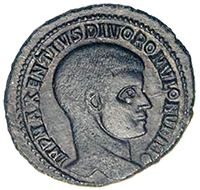7. Dies
No doubt great efforts were made to ensure that all dies prepared for a particular issue were the same. There are several differences which occur that make it easy to identify the different dies that were produced, where the differences are not simply due to the ravages of time. It is much more difficult however to be certain that two coins have been struck from the same die. Plates 33, 34 and 35 show that three different dies have been used for striking the obverse faces of the three Maxentian folles. All three reverses are mintmark MOSTP and show the Dioscuri only. Plates 21 and 22 have already been used to show differences in inscriptions. Plates 36 and 37 show that two different dies have been used in the production of folles bearing images of the Dioscuri.
 |
 |
 |
| Plate 33: The top of the laurel wreath is pointing to the NT of MAXENTIVS |
Plate 34:. ... is pointing to the N of MAXENTIVS |
Plate 35: ... is pointing towards the T of MAXENTIVS. |
 |
 |
| Plate 36: The heads are higher up and close to the lettering. |
Plate 37: ... are lower down and further from the lettering. |
Plates 38 to 41 show four obverse different faces of the same commemorative issue for Romulus (RIC 34). As can be seen clearly, the differences in shape of the back of the head and the line of the lower jaw point to at least four different dies being produced for this coin. As it so happens, all four coins carry the same mintmark namely MOSTS.
 |
 |
| Plate 38: Pronounced curve to lower jaw, back of cranium rounded. |
Plate 39: Much flatter lower jaw, back of cranium less rounded. |
 |
 |
| Plate 40: Gentle curve to lower jaw, back of cranium relatively flat. |
Plate 41: Ear lobe rounded. Base of nose points to S / C, in the other three examples to C / O. |